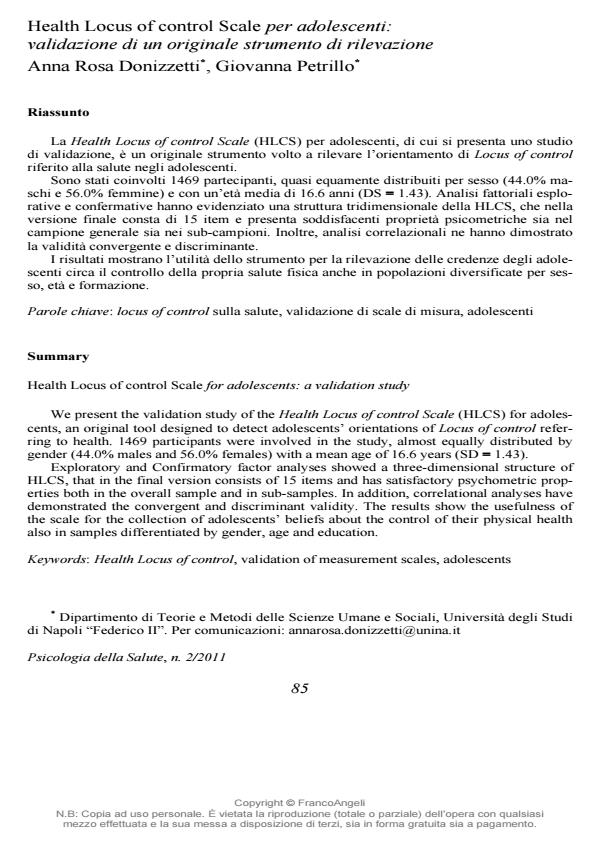Health Locus of control Scale for adolescents: a validation study
Journal title PSICOLOGIA DELLA SALUTE
Author/s Anna Rosa Donizzetti, Giovanna Petrillo
Publishing Year 2011 Issue 2011/2
Language Italian Pages 17 P. 85-101 File size 247 KB
DOI 10.3280/PDS2011-002006
DOI is like a bar code for intellectual property: to have more infomation
click here
Below, you can see the article first page
If you want to buy this article in PDF format, you can do it, following the instructions to buy download credits

FrancoAngeli is member of Publishers International Linking Association, Inc (PILA), a not-for-profit association which run the CrossRef service enabling links to and from online scholarly content.
We present the validation study of the Health Locus of control Scale (HLCS) for adolescents, an original tool designed to detect adolescents’ orientations of Locus of control referring to health. 1469 participants were involved in the study, almost equally distributed by gender (44.0% males and 56.0% females) with a mean age of 16.6 years (SD = 1.43). Exploratory and Confirmatory factor analyses showed a three-dimensional structure of HLCS, that in the final version consists of 15 items and has satisfactory psychometric properties both in the overall sample and in sub-samples. In addition, correlational analyses have demonstrated the convergent and discriminant validity. The results show the usefulness of the scale for the collection of adolescents’ beliefs about the control of their physical health also in samples differentiated by gender, age and education.
Keywords: <i>Health Locus of control</i>, validation of measurement scales, adolescents
- Ageism in an Aging Society: The Role of Knowledge, Anxiety about Aging, and Stereotypes in Young People and Adults Anna Rosa Donizzetti, in International Journal of Environmental Research and Public Health /2019 pp.1329
DOI: 10.3390/ijerph16081329 - University Student Mental Well-Being during COVID-19 Outbreak: What Are the Relationships between Information Seeking, Perceived Risk and Personal Resources Related to the Academic Context? Vincenza Capone, Daniela Caso, Anna Rosa Donizzetti, Fortuna Procentese, in Sustainability /2020 pp.7039
DOI: 10.3390/su12177039 - Paranormal Health Beliefs: Relations Between Social Dominance Orientation and Mental Illness Donizzetti Anna Rosa, in The Open Psychology Journal /2018 pp.35
DOI: 10.2174/1874350101811010035
Anna Rosa Donizzetti, Giovanna Petrillo, <i>Health Locus of control Scale</i> per adolescenti: validazione di un originale strumento di rilevazione in "PSICOLOGIA DELLA SALUTE" 2/2011, pp 85-101, DOI: 10.3280/PDS2011-002006